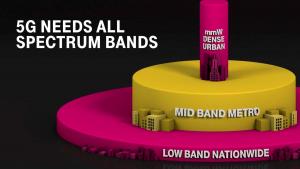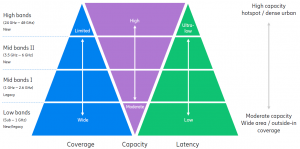The 5G Party is About to Start – Who’s Bringing the Cake?
23 JANUARY 2020
2020 will be the decade of 5G; transforming the wireless industry by harnessing spectrum that has never been used for cellular systems, and refarming existing spectrum to deliver on new 5G services.
T-Mobile USA’s CTO, Neville Ray, has popularized a graphic depicting 5G’s frequency ranges as a 3-layer cake, with the layers representing low, middle and high bands of 5G spectrum. His 5G cake is also a good visual for how these bands should be used by mobile network operators, while helping to dispel the myth that 5G is only about millimetre waves.

The T-Mobile USA 5G layer cake. Source- T-Mobile USA
Let’s start by looking at the bottom layer of the cake – the low spectrum bands, which range from 450 MHz to about 900 MHz. Until recently, the lower range of these low bands were used in many countries for digital TV services- but have recently been repurposed for mobile communications. The upper bands in this range are currently being used by 2G, 3G and 4G networks, and are now being re-farmed for 5G.
The main benefit of these lower bands is their reach, providing the best coverage of all the spectrum bands. With only a few cell sites, an operator can cover wide geographical areas. For this reason, this is the preferred spectrum for nationwide coverage. Having said that, this band is not available to every mobile operator, and it provides a true competitive advantage for those that have it because they will be able to roll out 5G services across larger areas that the other bands can’t reach. On the downside, the lower spectrum bands support less capacity, possibly necessitating the addition of spectrum from other bands.
The top layer of the 5G cake is the high band spectrum, ranging from 25GHz to 54 GHz. These frequencies are also known as millimetre waves because the radio waves are so short, measuring only 1mm to 10mm in length. This band has never been used for mobile communications, and it isn’t completely understood. For these reasons, accurate radio propagation modelling is a must for carriers using millimetre wave spectrum.
While they provide a lot of bandwidth, transmissions in the high band suffer from very short ranges, resulting in the need for many more cell sites to cover a given area, as compared to the low and mid-level bands. Millimetre waves are also very narrow in nature, meaning that a user typically needs to be within view of a transmitting antenna for a successful connection. On the plus side, they have the largest capacity of all the bands, supporting up to 200MHz. Millimetre waves also provide the lowest latency, which will be key for new URLLC services (Ultra Reliable Low Latency Communications), supporting things like connected cars and even remote surgery.

Performance of the 5G bands- Source: Nokia
Finally, we have the middle layer of the cake. Mid-band spectrum includes 1.8 GHz to 7 GHz. It offers the best compromise on all fronts; decent coverage, good capacity, and reasonable latency. It’s also widely available worldwide. For these reasons, most operators are rolling out 5G in the 3.5GHz band, with bandwidths from 40 to 130 MHz. This band has been used in the past for technologies like WiMAX and is well understood. It’s also widely available; which, along with its good performance and other capabilities, is the main reason why it has been chosen by many carriers as the primary 5G band.
So, the next time you enjoy a slice of cake, think of 5G. Whether it looks anything like T-Mobile USA’s 3-layer version will depend both on the country and the carrier. For some regions, 5G will be a 2-layer cake, where the base will be constructed of mid band spectrum, because there may not be any low bands available. For others, it will have only 1-layer for the initial rollout, then may gain more layers over time.
For help with successfully planning and managing your new 5G network, regardless of what your cake looks like, TEOCO provides a suite of solutions – including Forte for spectrum refarming, and Asset 5G for radio propagation modelling.
Written by Daniel Ramirez, RAN Solutions


